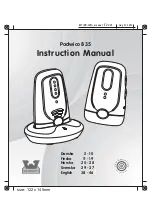
Owner’s Manual (Jacobson 600 Series –Ransomes 700 Series)
N14836 2 - November, 2002
3
Set-up and Operating Instructions Continued
Operating Continued:
WARNING:
Keep all guards, shields, and decals in place.
•
The gearboxes use SAE #90 gear oil and should
be checked regularly. Warranty will not be
allowed when it is evident that gears were run
dry.
•
Operator should not raise and lower blower
under heavy loads to gain traction.
•
Adjust the blower skid shoes so the cutting
blade is about 1/2” above the ground for best
results.
•
Do not use the snowblower as a bulldozer to
push snow, let the blower work its way through
the snow.
•
Wet sticky snow requires more power to blow.
The snowblower works better in this type of
snow if it is kept working at its full capacity.
•
Best operating speeds of fan depend on snow
conditions.
•
Do not use your hands or feet to unplug the
chute. Do not attempt to clear a plugged
chute while the snowblower is under power.
Disengage the PTO or hydraulic controls by
shutting off the power unit, remove ignition key,
wait for all movement to stop, and then clear the
snow from the chute using a wooden pole.
A definite pattern of operation is required to
thoroughly clean the snow area. The patterns shown
below will avoid throwing snow in unwanted places
as well as eliminating a second removal of snow.
Diagram “A” illustrates the removal of sow when it
is possible to throw the snow to the left and right, as
on a long driveway. Start in the middle and work
towards the opposite ends, throwing the snow to
both sides without changing the direction of the
discharge chute.
Diagram “A”
Diagram “B” illustrates the removal of snow when
snow can only be thrown in one direction of the
sidewalk or driveway. Start on one side of the area
that needs to be cleaned, set chute in the direction
required to discharge the snow and proceed. At the
end of the first pass, stop, turn
the machine around, rotate the chute 180 degrees
for the return pass. Completion of each pass will
require rotating the chute 180 degrees to maintain
the direction of discharge to be towards the same
area.
Diagram “B”
Содержание 481EFT
Страница 5: ...Section 1 Safety ...
Страница 11: ...Section 2 Operating ...
Страница 16: ......
Страница 17: ...Section 3 Maintenance ...
Страница 18: ......
Страница 24: ......
Страница 25: ...Section 4 Service Parts ...
Страница 26: ......
Страница 29: ......
Страница 30: ......
Страница 31: ......
Страница 32: ......
Страница 33: ......
Страница 34: ......
Страница 35: ......
















































